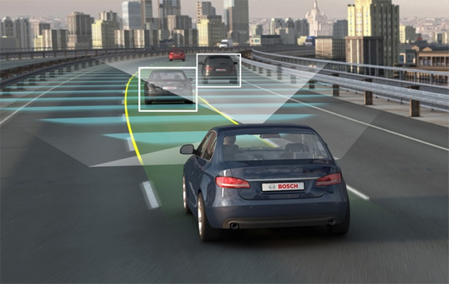In cases of crash between cars and other moving objects like animals and bikes, the visibility is the main problem, “I never saw him!” How many times have police officers heard that one, after someone plays bumper cars with real automobiles, bikes, kids, pedestrians, dogs, etc?
To help reduce the frequency of those incidents, Infiniti introduced their Backup Collision Intervention (BCI) option this year. It provides the driver with both visual and tactile warnings of trouble astern.
When the driver selects reverse, sensors directly behind and off the rear corners of the car scan the area for crossing traffic and stationary objects. If an object is present, flashing lights in the side-view mirrors, in the center dash display and three audible beeps indicate an obstacle. If the driver ignores that message by not stopping, the car automatically applies the brakes momentarily. After a few seconds, though, the driver has to apply the brake more fully to keep the car stopped.
Similarly, if the driver is applying throttle rather than the brakes when the system is generating the warning, the accelerator pedal pushes back. If the driver resists that warning, the brake pedal is not applied. Since the system is aimed at parking lot and driveway assistance, it is only active below 5 mph.
The BCI system is bundled with the $1,900 Driver Assistance Package and also requires the $3,000 Premium Plus navigation, traffic info and voice recognition package.
We tested it and it worked just as advertised. Editor-in-Chief David Kiley even put himself potentially in harms way, walking into the rear area of the car. The system worked perfectly, which made it a finalist for Technology of the Year.
Long a pioneer in auto safety (the first company with seat belts, after all), Volvo introduced a new system this year that recognizes both pedestrians and bicyclists ahead of the car to alert and avert collisions. Pedestrian and Cyclist Detection with Full Auto Brake alerts drivers to impending collisions and if the driver does not respond to the alert, the system can stop the car to avert or minimize a major impact.
This system, voted an AOL Autos finalist for Technology of the Year by the judges, builds upon one that Volvo has had for many years that focused on vehicles in front of the Volvo’s path called Auto Brake. Now, with Pedestrian and Cyclist Detection, a radar unit assesses the speed of objects and works with a fast-acting camera that serves to profile the size and shape of the objects. It continually monitors movements, trajectories and profiles of objects. Profiling for safety, if you will.
If the system calculates that contact is imminent, a red warning illuminates in front of the driver. If the driver does react to the warning, the system stands down. If the driver does not react to the warning, full braking pressure is engaged autonomously and sufficient to engage the anti-lock braking system. It doesn’t guarantee accident avoidance (no such system does) but it will lessen impact severity and could completely avert an impact.
Most significantly, Volvo offers Pedestrian and Cyclist Detection across the 2014 line as standard equipment. It’s part of Volvo’s overriding vision of keeping occupants safe should danger befall them and ultimately, working towards averting all crashes and impacts.



